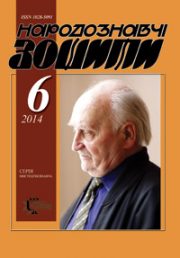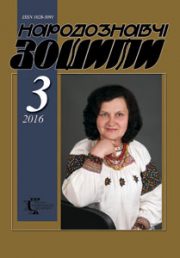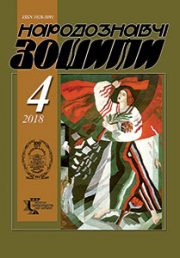The Ethnology Notebooks. 2022. № 5 (167), 1059—1079
UDK 721(477.85/.87-22)”1990/2018″
DOI https://doi.org/10.15407/nz2022.05.1059
MODERN ARCHITECTURE OF HUTSULS: FEATURES AND SPECIFICS OF FORMATION
RADOVYCH Roman
- ORCID ID: http://orcid.org/0000-0002-1900-8948
- Doctor of Sciences in History, Senior Researcher
- of the Institute of Ethnology
- of the National Academy of Sciences of Ukraine,
- in the Department of Historical Ethnology,
- Svobody Avenue, 15, 79000, Lviv, Ukraine,
- Contacts: e-mail: radovychroman@gmail.com
Abstract. In the process of development, various factors that determine the functional viability, regional diversity, appearance, etc. of both individual objects (residential, public and other purposes) and the architectural complex as a whole influenced on folk architecture. In fact, all this determines the relevance of the paper.
The author aims to identify the features of rural development of modern Hutsul village in independent Ukraine, to trace the specific features of its components, the degree of external influences, the use of traditional elements of local folk architecture, and to clarify the understanding of indigenous concepts such as «Hutsul architecture», in general, and «modern Hutsul architecture».
The object of research is the traditional folk architecture of the Hutsuls, and the subject — its development in modern times.
The methodological basis of the study is the principle of historicism in combination with elements of structural and functional analysis and the use of basic methods of ethnological science: typological, comprehensive and retrospective analysis, historical reconstruction and more. The territory of the study covers the entire territory of Hutsul region within Ivano-Frankivsk, Zakarpattia and Chernivtsi regions.
The period of the research: the beginning of the 1990s—2018 inclusive.
In modern ethnological science, the declared problem has been never considered, so the basis of the work is information collected during expeditions conducted in 2015—2018; tourist and recreational complexes, catering establishments — huts, as well as small architectural forms (chapels, roadside wells, fences), etc.
Keywords: Hutsul region, modern architecture, housing, sacred buildings, tourist and recreation complexes.
Received 30.09.2022
REFERENCES
- Mohytych, I.R. (1987). Public buildings. Hutsulshchyna (Pp. 182—188). Kyiv: Naukova dumka [in Ukrainian].
- Siletskyi, R. (1994). Rural settlement and estate in the Ukrainian Carpathians of the 19th—20th centuries. Kyiv: Naukova dumka [in Ukrainian].
- Shukhevych, V., Vatamanyuk, D., & Arsenych, P. (1997). Hutsulshchyna (Part 1—2). Verkhovyna: [b. v.]. Reprint of the 1899 and 1901 editions [in Ukrainian].
- Mohytych, I.R. (1987). Residential and farm buildings of the yard. Folk architecture of the Ukrainian Carpathians of the 15th—20th centuries (Pp. 69—125). Kyiv: Naukova dumka [in Ukrainian].
- Hoshko, Yu.G., Kishchuk, T.P., & Fedaka, P.M. (1987). Development of settlements, housing and living conditions in the Soviet period. Folk architecture of the Ukrainian Carpathians of the 15th—20th centuries (Pp. 244—258). Kyiv: Naukova dumka [in Ukrainian].
- Fedaka, P.M. (2005). National housing of Ukrainians in Transcarpathia of the 18th—20th centuries. Uzhgorod: Grazhda [in Ukrainian].
- Danyliuk, A. (1985). Bow to the folk architect. Ethnographic essays on folk architecture of Ukraine. Lviv: Svichado [in Ukrainian].
- Kosmina, T.V. (1980). Rural housing of Podillia (late 19th—20th centuries): historical and ethnographic study. Kyiv: Naukova dumka [in Ukrainian].
- Samoilovych, V.P. (1977). Folk architectural creativity (based on the materials of the Ukrainian SSR). Kyiv: Budivelnyk [in Ukrainian].
- Hratsianskaia, N.N., Listova, N.M., & Tokarev, S.A. (1968). Introduction. Typology of folk housing in the countries of foreign Europe. Types of rural housing in the countries of foreign Europe (Pp. 3—11). Moscow: Nauka [in Russian].
- Pavliuk, S. (2008). Dictionary of basic concepts and terms from the theory of ethnology. Lviv [in Ukrainian].
- Holovatskyi, Ya. (1993). Journey through Galician and Hungarian Rus, described in letters to a friend in L. Journey to the Ukrainian Carpathians (Pp. 22—101). Lviv: Kameniar [in Ukrainian].
- Falkowski, J. (1937).The western border of the Hutsul region: the Valleys of Prut, Bystrica Nadwornianska, Bystrica Soljtwinska and Lomnica. Lwow [in Polish].
- Falkowski, J. (1938). North-eastern border of the Hutsul region. Lwow [in Polish].







